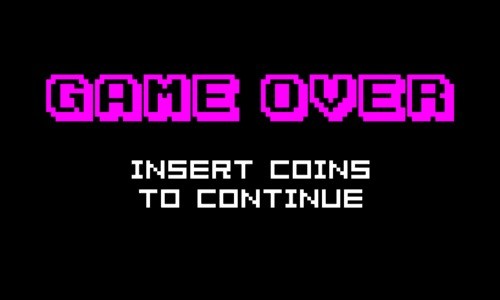The extreme difficulty of the video games of the past


If you think that the video games of the past weren't extremely difficult, it is simply because you have forgotten. If you think games like Dark Souls are difficult, it's because you don't know the history of video games.
Video games were once not for everyone, but only for those who had the ability to play them, which today is very simple, but which at the time was not.
The passage of time is making us forget what for many years was a problem of no small importance for the gamer, that is, the fact that the video games of the past had such a high difficulty as to require great efforts to continue and are sometimes almost impossible to finish, being much more difficult than modern games considered as such, for example as the Dark Souls which are in fact easier games than those of the past, but which are absurdly considered among the most difficult games ever made.
It is no coincidence that in all the rankings of the most difficult games in history, old games from the 80s appear. In fact, in the 80s and 90s video games were basically set to an extremely high difficulty level, and it made it an exceptional event to be able to finish one. In fact, they required a lot of effort and study to be able to advance in the game, which the average gamer usually could not dedicate to them. This obviously does not mean that they were bad (by the standards of the time), but it does mean that they were usually very difficult.
In fact, video games are born as arcade games, rooms full of video games where you had to pay to play a game and then continue to pay every time the available lives ran out. Consequently, the interest was to make a video game as difficult as possible so as to get as much money from the players, it was starting from an affordable difficulty level to attract people, and then there was a sharp surge to a very difficult level, so that you end your lives and have you insert new coins to continue.
The concept of finishing a game in the average gamer did not exist, given the barriers due to the difficulty sucking money and given the enormous availability of games in the arcade, we were limited to making short games of different games.
At the beginning of the videogame era, games did not have an ending: when you reached a certain level, it simply started over with a greater difficulty, and only later an insignificant screen of text was inserted as an ending. Then we moved from the text screen to one or more images, up to real animations.
When video games entered homes, through consoles and computers, they did nothing but adapt to the model of the Games Room, and therefore proposed the same schemes and unfortunately also the same difficulty, with the difference that at home you could not insert other coins to continue, and therefore there was always an insufficient number of lives and continuations to finish the game. And if you have forgotten it, look back at what games you played in your era and how few of them you managed to finish without tricks (if none or almost none do not worry, you are in good company).
At the time, the average gamer considered it a success to have played a video game and managed to pass the first level, while finishing it seemed pure science fiction.
However, the playing style of the Games Room had been exported, and therefore the average gamer played short games of different games, without thinking of finishing the video games, in this case also conditioned by the excessive effort that the latter required to be completed. The problem is that if you had few games or were stubborn about wanting to see how a game progressed, then the inability to overcome the wall of difficulty could become an unpleasant thing.
There were also those who desperately bought cards and cartridges, far from cheap, created specifically to give a chance to be able to use the tricks. In fact, a unique peculiarity of the time was the fact that the exaggerated difficulty of the video games of the time created a market of cartridges and hardware expansions, both on Computers and on Consoles, which served precisely to give the possibility to use tricks (such as Action Replay , Game Genies and Final Cartridges).
In short, the very high difficulty became a standard for all video games, with the aggravating circumstance that often, too often, the games were even more difficult due to the incompetence of the programmers who on the one hand created completely busted difficulty curves, with moments incredibly difficult after a normal gameplay, and on the other hand they miscalibrated game parameters such as collisions, trajectories of objects on the screen, jumps to be made, time required to complete a level, number of challenges to be faced simultaneously on the screen, explanations to give on key elements of the game, etc .. There is a very successful youtube channel where the Angry Videogame Nerd literally goes crazy thanks to games programmed in this way.
The Arcade was very popular in the 1980s and 1990s, and as a result, home video games suffered greatly from its influence during this period. Only with the end of the Arcades, due to the Playstation and the like, did a gradual process begin that led to the reduction of the difficulty from very high levels to normal levels.
But the fault was not only the games room, but also the technical limitations of the time. In fact, due to the low power of the machines and above all the low capacity of the supports, the video games had few levels, which means that at a normal difficulty the game could have been finished in a very short time. But the games of the time were extremely expensive, and when you bought them they had to last a long time to make up for that money outlay, and then you found yourself on such a high level of difficulty that you had to repeat the game from the beginning over and over again to get you going. more and more forward. On the other hand, the standard of the games room was that, and therefore there was no difference with what was the concept of the video game of the time.
In fact, pre-playstation home video games were basically divided into three genres:
- there were Arcade conversions, which were the most sought after, even though it was actually the kind of game designed to get money out of people who would have had to keep chasing money to play, but at home it was not possible to do so and therefore in fact you got to a point where you could not continue and the end of the game was difficult to reach (however there was a real obsession in wanting to convert the Arcade game home);
- there were games that had the same style as those of the games room, and these too were sought after, but in fact they proposed the same arcade scheme that made them very difficult;
- there were games that differed completely from those of the Games Room, but which unfortunately had adapted to a climate of high difficulty, and therefore there were strategies, simulations, role-playing games and adventures that were complex and severe.
With the first Playstation and the other systems of the time, there was the death of the Games Room and therefore the disappearance of a reference model that influenced the entire videogame landscape, as well as the availability to be able to play complex and long games, and then slowly the difficulty went down to normal levels, it became a practice to be able to save and even to be able to choose the level of difficulty.
But it was a long process, the games for Playstation 1 for example were still difficult, even if not very difficult, and it is enough to compare the games of now with the games of the time where you had to be careful at every step and every resource to be used. .
Gaming seriously was really challenging in the 80s and 90s, and if you had popular computers like Commodore 64 and Amiga it was even more so. In fact, many machines, including these, had only one fire button, but in fact the games would have required an average of three and a minimum of two, and this made it necessary to make a whole series of combinations that made it even more difficult to play. but the programmers did not take it into account and in any case they gave you the usual very difficult game, to which, however, you had to add a complex control system.
Those who had video games on cassette and with multiple levels loading separately, which were usually important games, also had to suffer the punishment of having to reload a game from the beginning if you died from the second level onwards, rewinding the tape from the beginning, which it was not at all pleasant as the loading times on tape were very long. Having, by their nature, to repeat a video game over and over again to be able to continue more and more, you understand how difficult it was to do it when you were using games with these characteristics.
But as mentioned, they were all difficult, just think of the simulations made as complex as possible, of the adventures where you got stuck easily and you didn't have the slightest idea how to go on, of the very popular 2D platformers and shooters that required both a practically perfect precision that the memorization of what moved on the screen. The games that came out of these screens were really rare (such as Turrican 1 and 2), and although they were highly appreciated for this feature, they did not manage to influence the landscape of the time.
Video games were in fact very punitive, sometimes at levels of high sadism when at the first blow or touch you died, but in general there were few and continuous lives and after having toiled the seven shirts, when you died for the last time it always happened that the game would kick your ass back to its beginning to have to do it all over again, which in a game with so many obstacles that you had laboriously (or miraculously) overcome, seemed more like a punishment than anything else.
The games of the time, generally, not only required timing on precision movements, but required it in a context of endless waves of enemies, gunfire and obstacles, which seemed to have been deliberately drawn to cut off escape or forward movement.
Some games went even further, as they were made in such a way that you didn't really understand what you had to do or how the game mechanics worked, and therefore the first challenging part was understanding how they worked (with certain home games it was no small feat. ).
The concept of "unfair" was also widespread in video games of the past: there were some games, even very famous ones, which contained hallucinating bastards put up by programmers, like the usual enemies that appeared in your trajectory when you jumped or the usual almost impossible jump with pinpoint precision, or the classic absolutely unpredictable element placed there only to make you lose a life (as in Ghosts' n Goblins and the first Ninjia Gaiden).
The only way to pass those points was to die until you learn the technique of overcoming these obstacles, and then either spend money in the arcade or start the game all over again at home.
To be mentioned, for example, even when you did not give the possibility to continue (not even in the Games Room) if you died in the last level of the video game that you had reached by sweating the seven shirts or by spending many tokens (as in Rastan, in Shinobi or in Wonder Boy in Monster Land).
Or again it is worth mentioning the bastard of making you get to the completion of the game with a lot of effort (or money) and then telling you that it is not the real ending and that you have to start all over again as you have not collected the objects necessary for the true completion of the game. game, and obviously the player was unaware of this essential detail (as in Rainbow Islands).
As well as when it was impossible to access the real ending of the game if you weren't playing in two, obviously without any prior indication of the thing (as in Bubble Bobble), or when to really finish the game it was necessary to complete it twice, perhaps with the second time to even greater difficulty (again as in Bubble Bobble or as in Ghosts' n Goblins).
There was also the mockery of games that seemed to take you somewhere but in reality never ended, proposing endlessly levels with increased difficulty (as in Pac Land), or absurd nasty such as traps not foreseeable by the player that suddenly appeared. and they would kill you and objects that are supposed to be harmless that if you touched them made you lose your life (like in Treasure Island Dizzy).
And how not to mention the fact that many, many games of the time (even famous ones) were extremely difficult because ... badly programmed! The art of programming a game well was far from common in the past. There are also limit cases of famous games that could not be completed because in a forced passage a technically impossible leap had to be made (as in Rastan for C64 or in Teenage Mutant Ninja Turtles for Ms-Dos).
Or there were objects needed to finish the game that were impossible to find (as in Asterix for C64), or it could happen that a time limit had been placed to finish a level that was so low that it was technically impossible to succeed in the enterprise ( as in Robocop for C64). Or maybe it happened to you that you couldn't tackle the final level of a game due to a bug (like in Golden Ax for C64).
It also happened that the programmers peddle a serious bug that prevented them from finishing the game, and that they couldn't fix in time, as an intentional thing done to make the game more difficult, only to later admit the programming error (as in Jet Willy set for Spectrum).
And no, the specialized magazines of the time that reviewed the games did not inform the readers of the presence of these serious problems, and their vote therefore completely disregarded their presence. in fact, re-reading the reviews of the era of games with problems in advanced levels today, we realize that video games were often reviewed without being finished and even without reaching advanced levels, and this is because they were so difficult that video game reviewers despite being experts could not finish them or get to advanced levels in periods of time to be able to do a review.
Indeed, they could not even afterwards, given that in the reviews of the economic editions of the same video games, despite the past years, the serious defects that manifest themselves at advanced play were absolutely not mentioned.
Obviously in the 80s and 90s there was no shortage of hardcore gamers, that is, there were competitive people who had the patience and the ability to study the game and learn all the necessary steps and movements (often by heart), as well as have the adequate reflexes to be able to finish a video game. But it was a small minority of gamers, finishing a game was not impossible but it was certainly very difficult and required study, perseverance, skill and a lot of patience.
The vast majority of gamers, however, were unwilling to make these sacrifices, and therefore accepted to play conscious of the fact that such a difficulty would have prevented them from continuing in the game (at home) or would have led to a large outlay of coins (in the Games Room. ), but it is useless to deny that there were cases in which the high difficulty caused anger and frustration. On the other hand, it was not nice to repeat a game over and over again and then never be able to go beyond a certain level, which was more common than thought in the average player.
But the games of the 80s and 90s, with a few exceptions, were not created to be completed, but their purpose was to offer an extremely high level of challenge, and the concept of fun that was proposed was to make a path of improvement to face very difficult challenges. On the other hand, with a normal challenge level, the game was finished in half an hour, or at most an hour, and then the huge outlay of money to buy it would have seemed a blatant scam. Video games at the time were not for everyone, many were satisfied with having many games to which they played short games without too much effort, few made great sacrifices to beat the game and go as far as possible.
Today clearly no one would appreciate games of the difficulty of the genre, and the same games of today considered as very difficult, for example Dark Souls, are actually easy when compared to the past, where perfection was really required throughout the game to be able to finish it, so perfection of movements and memorization of enemy movements, as well as excellent reflexes and a lot of patience in having to start the game over and over again to get to master it in this way.
And the saves did not exist, often not even the checkpoints: they were subsequently inserted not to make the game easier, but only for reasons of game length, just as there was no possibility to choose the difficulty level, and if it existed it was only for being able to switch between levels of difficulty, however high.
In fact, it is no coincidence that the video game audience of the past was smaller than that of today, and in that same audience there are very few people who managed to finish a few games.
It must be said that the enormous difficulty that forced video games to be repeated endless times has led to a phenomenon that will be lost forever over time, and that is the fact that the most avid gamers of the time, after so many years, remember the first levels of the games they played very well, as if the constant repetition had burned them into their minds. But not only that, this phenomenon has also led to making people very fond of titles that were repeated constantly in their youth, with a nostalgia effect that is incomparable to that of the most recent video games.
This psychological aspect is very interesting because there is a huge difference in nostalgia, memories and interest between the time when the games were extremely difficult and had to be repeated over and over from the beginning, and the times in which the games had normal difficulties and essentially played once or twice.
Returning to modern games considered the most difficult of all, Dark Souls, unlike games of the past, give margin for error in fights, even allow you to heal yourself, there are no time limits, has a high number of save-checkpoints and you even have infinite lives. Yes, Dark Souls requires patient strategy and a good understanding of enemy attack patterns - the only problem is that this is only difficult when compared to modern casual video games, but compared to old school, hardcore games, Dark Souls it's a real walk.
But the one between the Dark Souls and the games of the 80s and 90s is still a risky comparison as the games of the time were created or for the Arcade and therefore to make you lose and make you spend as many coins to continue, or for the home market where they tried to reproduce this sensation typical of the games room, which the gamers of the time lived constantly and which therefore they considered normal and even desirable. That all too often people rely on cheap tricks and low-level design to increase the difficulty, that's another story.
Clearly time has erased the memories of this in the memory of the average gamer of the time, and therefore the old video games are remembered much more playable than they were, but just playing them today to realize how difficult they were and required a lot of effort. However, the very powerful phenomenon of nostalgia even manages to exalt historical video games of the past that actually have an exaggeratedly high difficulty, and it is useless to make endless lists of games of the genre because as we have said it was the standard for games of the past.
But all this seems to have been forgotten by the world, given that Dark Souls is listed everywhere for example among the most difficult games ever as in reality it does not even come close to the difficulty of the video games of the past: and if you have forgotten (or do not know) the great difficulty of 80s and 90s video games, we invite you to play them without tricks and without endless continuos, and it will be a rediscovery of what has been said so far. Or, just think about how many games of that period you failed to finish or how many of them you could not advance beyond a certain level despite numerous attempts ...
Insights and curiosities on the subject
In all the rankings of the most difficult games ever, many titles of the past often enter unanimously although, only considering the famous titles and wanting to be objective, we should include many more, but it is obvious that endless lists of difficult games would not be readable.
For example, if you want to take the period 1985-1995, famous games such as Ghosts 'n Goblins, Ghouls' n Ghosts, Contra, Battletoads, Mega Man 1 and 2, Mega Man 9, Mike Tyson's enter rightfully among the most difficult titles in history. Punch-Out !!, Silver Surfer, Green Beret, Teenage Mutant Ninja Turtles, Zelda 2: The Adventure of Link, Castlevania, Castlevania III, Narc, Smash TV, Marble Madness, Super Mario Bros The Lost Levels, Ninja Gaiden, Tower Toppler (Nebulus), Treasure Island Dizzy, Cauldron, Cauldron II: The Pumpkin Strikes Back, Dr. Jekyll and Mr. Hyde, R-Type, Xenon 2, Rick Dangerous, Enlightenment Druid II, Project-X, Comix Zone, SWIV, UFO : Enemy Unknown, Super Ghouls' n Ghosts, Myst, Shadow of the Best 1 and 2, Apydia, Earthworm Jim, Solomon's Key, The Simpsons: Bart Vs. The Space Mutants, etc.
It must be said that the video games for PC Ms-Dos, which often moved on different logics, anticipated the change by a few years, offering games with more accessible difficulty than the competition, and therefore it should not surprise the success of certain Dos titles. with difficulties at much more accessible levels than the competition.
Here are some famous examples: Strike Commander, Comanche, X-Wing and sequels, Wolfenstein 3D and clones, Doom and clones, Panzer General, Warcraft 2, Full Throttle, Jill of the Jungle, Xargon, the Duke Nukem saga, the saga of Commander Keen, Cosmo's Cosmic Adventure, Jazz Jackrabbit, etc.
For computers, and especially for Commodore 64 and Amiga, there was an important phenomenon that influenced the way of playing. In fact, there was widespread piracy, even for a long time accessible en masse even from newsstands, which allowed the gamer to get hold of an infinity of different video games at very little expense.
This large availability of games led to the fact that people did not usually focus on a few games, and therefore did not spend a lot of time on them or made great sacrifices to learn how to finish them, but limited themselves to many short games of many different games (except for the a few favorites to which they spent more time).
Instead, it was different for the consoles, where gamers had few games paid for at a high price that had to be enough even for months: one can well imagine how much time was dedicated to them.
PS: it should be clear that throughout the all what has been written here referred to arcade games that worked correctly, because it was not uncommon to find crafty arcade managers who, by acting on the switches, had set the machines on maximum difficulty so to make the games last even less and earn more money, just as it was not uncommon to find game cabinets with controls that have become more or less inaccurate due to too much use. All of this made it even more difficult to play than described so far, in a way that we cannot consider correct even taking into account the money-eating function of the machine.
And for the sake of completeness we add that even the pinball machines were the object of incorrect practices to make you lose faster, being modified not only with smaller racquets in order to allow more passage for the ball to get in the middle, but also with the application of rubber rebounds. cleverly placed so that when the ball went into the two right or left channels 90% of the time it entered the two external ones that made the ball lose.






















